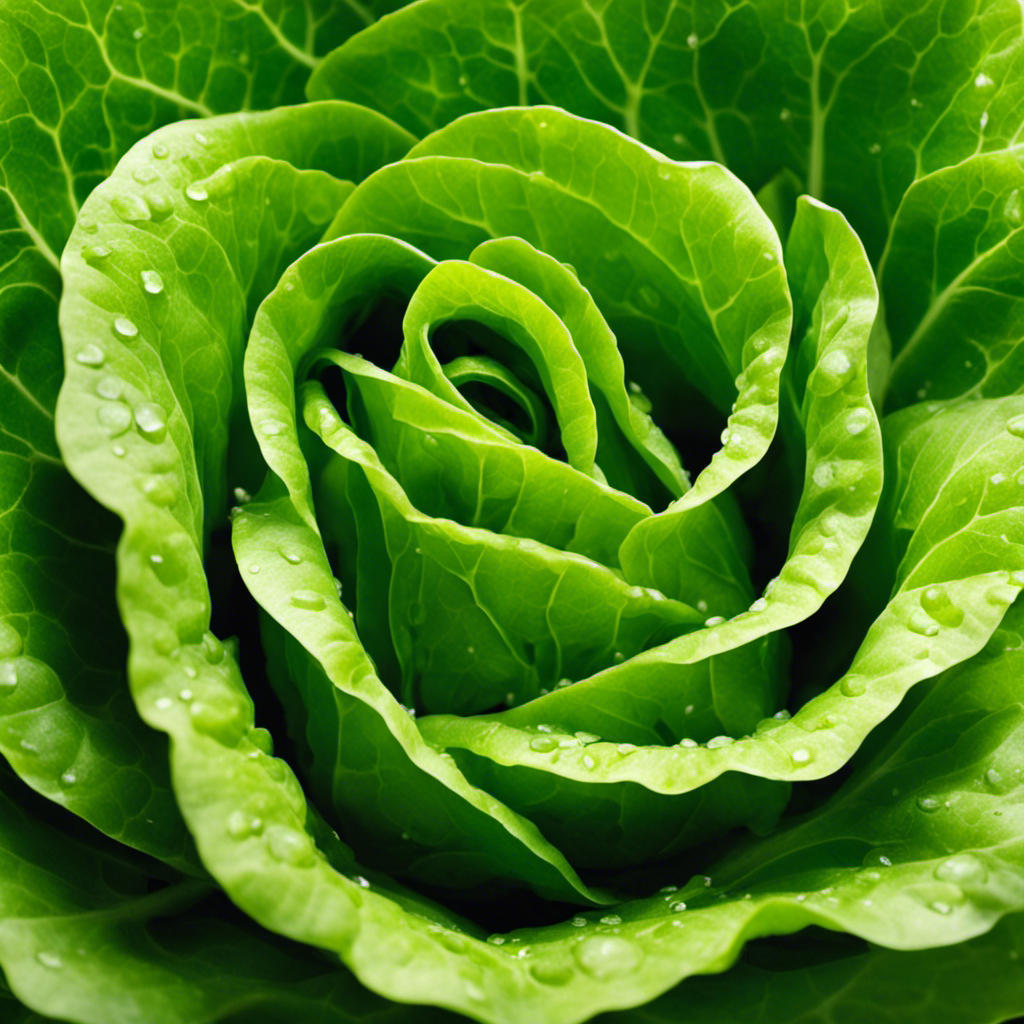Recipes & Culinary Uses
Make Rich Cacao Butter at Home
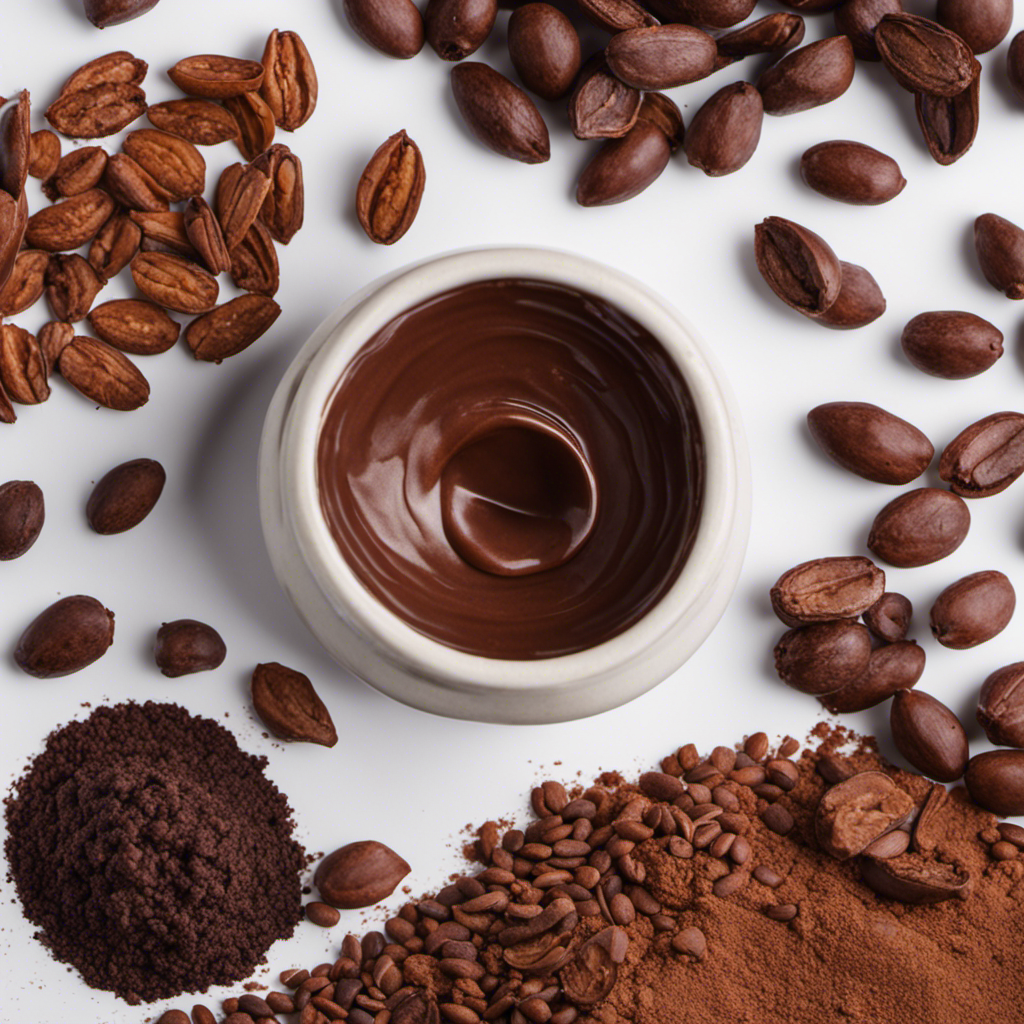
I’ve consistently been captivated by the luxurious and smooth consistency of cacao butter. It feels like a gentle caress on your palate, infusing a lavish flair into every dish.
In this guide, I’ll show you how to make your very own cacao butter from scratch. From selecting and preparing the cacao beans to melting and straining the butter, I’ll walk you through each step with precision and clarity.
Get ready to embark on a delicious journey into the world of homemade cacao butter!
Key Takeaways
- Properly selecting and preparing cacao beans is crucial for high-quality butter production.
- Roasting unlocks the full potential of cacao beans for high-quality butter.
- Efficient separation techniques are crucial for high-quality butter.
- Filtering extracted cacao butter removes impurities for smoother texture.
Selecting and Preparing Cacao Beans
Before you start making cacao butter, you’ll need to select and prepare the cacao beans.
The first step is to choose high-quality beans that are fully ripe and free from any defects.
Once you have selected the beans, the next step is to prepare them through a process called dry fermentation. This involves placing the beans in a container and allowing them to ferment for several days.
During this time, the beans undergo chemical changes that enhance their flavor and aroma.
After fermentation, the beans are spread out in the sun to dry. Sun drying helps to remove excess moisture and further develop the rich flavors of the beans.
Once the beans are fully dried, they are ready to be processed into cacao butter.
Roasting and Grinding the Cacao Beans
Once you’ve roasted and ground the cacao beans, it’s time to move on to the next step in the process. Roasting techniques play a crucial role in developing the flavor profiles of cacao beans.
The roasting process brings out the complex flavors and aromas hidden within the beans. Different roasting times and temperatures can result in distinct flavor profiles, ranging from fruity and floral to nutty and earthy.
As a chocolatier, I experiment with various roasting techniques to achieve the desired flavor notes in my cacao butter. By carefully monitoring the temperature and duration of roasting, I can enhance the natural flavors of the beans and create a unique taste experience.
The roasting step is essential in unlocking the full potential of the cacao beans and ensuring the highest quality cacao butter.
Separating the Cacao Nibs From the Cacao Butter
When it comes to separating the cacao nibs from the cacao butter, efficient separation techniques are key.
This process is crucial in ensuring a high-quality butter extract.
Efficient Separation Techniques
To efficiently separate the cacao butter from the cacao nibs, you can use a technique called pressing. Here are four steps to maximize cacao butter yield:
-
Grinding: First, the cacao nibs are ground into a fine powder using a grinder. This step increases the surface area of the nibs, making it easier for the butter to be extracted.
-
Heating: The ground cacao powder is then heated to a specific temperature. This helps to melt the cacao butter, making it easier to separate from the solids.
-
Pressing: The heated cacao powder is placed in a hydraulic press. Pressure is applied, forcing the cacao butter to separate from the solids. The butter is collected, while the remaining solids, known as cacao cake, are discarded.
-
Filtering: Lastly, the collected cacao butter is filtered to remove any impurities, ensuring a pure and high-quality final product.
Quality of Extracted Butter
To ensure a high-quality final product, you should filter the extracted cacao butter to remove any impurities. This step is crucial in achieving the desired texture and consistency of the butter.
By removing impurities such as debris or any remaining cocoa solids, you can create a smoother and more refined butter. Additionally, filtering helps to prolong the shelf life of the butter and ensures its freshness over time.
It is recommended to use a fine mesh strainer or cheesecloth for this process to effectively remove any unwanted particles. Once filtered, store the cacao butter in an airtight container in a cool and dark place to maintain its quality.
Proper storage will help preserve the butter’s flavor and prevent it from becoming rancid.
Melting the Cacao Butter
When it comes to melting cacao butter, there are two key points to consider: the ideal melting temperature and the time required for melting.
The ideal melting temperature for cacao butter is around 104-113°F (40-45°C), as this ensures a smooth and consistent melt without compromising the quality of the butter.
The time required for melting can vary based on the quantity of cacao butter being melted, but generally it takes around 15-20 minutes for the butter to fully melt.
Ideal Melting Temperature
The ideal melting temperature for cacao butter is around 90 to 95 degrees Fahrenheit. To achieve this temperature, various melting methods can be employed, depending on the equipment available. Here are four common methods used for melting cacao butter:
-
Double Boiler Method: This involves placing the cacao butter in a heatproof bowl, which is then set over a pot of simmering water. The indirect heat gently melts the butter without scorching it.
-
Microwave Method: Cacao butter can be melted in a microwave-safe bowl by heating it in short intervals and stirring in between. This method requires careful monitoring to prevent overheating.
-
Sous Vide Method: By placing the cacao butter in a vacuum-sealed bag and submerging it in a water bath set at the desired temperature, precise control over the melting process can be achieved.
-
Melting Pot Method: Using a specialized melting pot or chocolate melter, the cacao butter can be melted gradually and evenly, ensuring a smooth consistency.
Now that we know the ideal melting temperature and the various methods and equipment needed, let’s explore the next step: the time required for melting.
Time Required for Melting
You can determine the time required for melting by considering the method and equipment you are using. The melting time of cacao butter can vary depending on various factors such as the temperature, the size and shape of the cacao butter pieces, and the melting technique employed.
If you are using a direct heat method, such as a double boiler, it may take around 10-15 minutes for the cacao butter to melt completely. On the other hand, if you are using an indirect heat method, like a sous vide machine, it may take longer, approximately 20-30 minutes.
It is important to note that the melting time can also be influenced by the quality of the cacao butter and the consistency of the heat source. Therefore, it is crucial to closely monitor the melting process to ensure a smooth and consistent result.
Straining and Filtering the Cacao Butter
To strain and filter the cacao butter, start by placing a fine mesh strainer over a clean bowl. This will help remove any impurities and ensure a smooth texture.
Here are some straining techniques and alternative filtering methods you can use:
-
Cheesecloth: Line the strainer with cheesecloth to catch any small particles or solids present in the cacao butter.
-
Coffee filter: For a finer filtration, you can use a coffee filter instead of a mesh strainer. This will give you a smoother and more refined cacao butter.
-
Chinois: A chinois is a cone-shaped strainer with a very fine mesh. It is often used in professional kitchens for straining sauces and liquids. It can also be used to strain cacao butter for a high-quality result.
-
Nut milk bag: Similar to a cheesecloth, a nut milk bag is a fine mesh bag that can be used to strain the cacao butter. It is especially useful for removing any remaining solids or sediment.
Once you have strained and filtered the cacao butter, you can move on to the next step of storing and using the homemade cacao butter.
Storing and Using the Homemade Cacao Butter
Once strained and filtered, I store my homemade cacao butter in an airtight container. It’s crucial to keep it in a cool, dry place to maintain its freshness and flavor. Storing cacao butter correctly ensures that it remains in perfect condition for a long time.
Besides using cacao butter in skincare, it can also be incorporated into various recipes. When used in skincare, cacao butter provides deep hydration and nourishment to the skin, leaving it soft and supple. It can be used in homemade body butters, lip balms, and moisturizers.
In recipes, cacao butter adds a rich and creamy texture to dishes like chocolate desserts, smoothies, and even savory sauces. Experimenting with cacao butter in both skincare and cooking can unlock a world of delicious and skin-loving possibilities.
Frequently Asked Questions
How Long Does It Take to Make Cacao Butter From Start to Finish?
It takes a considerable amount of time to make cacao butter from start to finish. The cacao butter making process involves several steps that require patience and attention to detail.
Can I Use Any Type of Cacao Beans to Make Cacao Butter?
Yes, you can use different types of cacao beans to make cacao butter. The extraction process remains the same regardless of the variety. However, the flavor profile may vary depending on the beans used.
Are There Any Health Benefits to Using Homemade Cacao Butter Compared to Store-Bought Options?
There are potential health benefits to using homemade cacao butter compared to store-bought options. Homemade cacao butter allows for control over the ingredients and process, potentially resulting in a higher quality product.
Can I Add Any Additional Flavors or Ingredients to the Cacao Butter?
Yes, you can enhance the flavor of cacao butter by adding various ingredients. Flavor variations can be achieved by incorporating spices, such as cinnamon or vanilla, or by using alternative ingredients like coconut oil or almond extract.
How Do I Know if the Cacao Butter Has Gone Bad and Is No Longer Safe to Use?
When it comes to cacao butter, it’s important to know if it’s gone bad. Signs of spoiled cacao butter include a rancid smell and taste, as well as a change in texture. Its shelf life is generally around 2-5 years.
Conclusion
In conclusion, making cacao butter at home is a meticulous process that requires patience and attention to detail. From selecting and preparing the cacao beans to melting and straining the butter, every step plays a crucial role in achieving the desired end result.
By following these steps, you can create your own homemade cacao butter, a versatile ingredient that can be used in various culinary creations.
So, why wait? Start experimenting with cacao beans and unlock a world of rich, velvety flavors that will leave your taste buds craving for more.
Diana’s meticulous nature and editorial prowess set the gold standard for our content. With over a decade in the culinary and publishing industries, her guidance ensures that every article perfectly blends information and entertainment. A culinary experimenter, Diana loves whipping up new butter-based concoctions in her kitchen.
Recipes & Culinary Uses
Creamy Delight: Best Butter Pecan Ice Cream Recipe for Summer!
Yearning for a creamy summer treat that will leave you craving more?
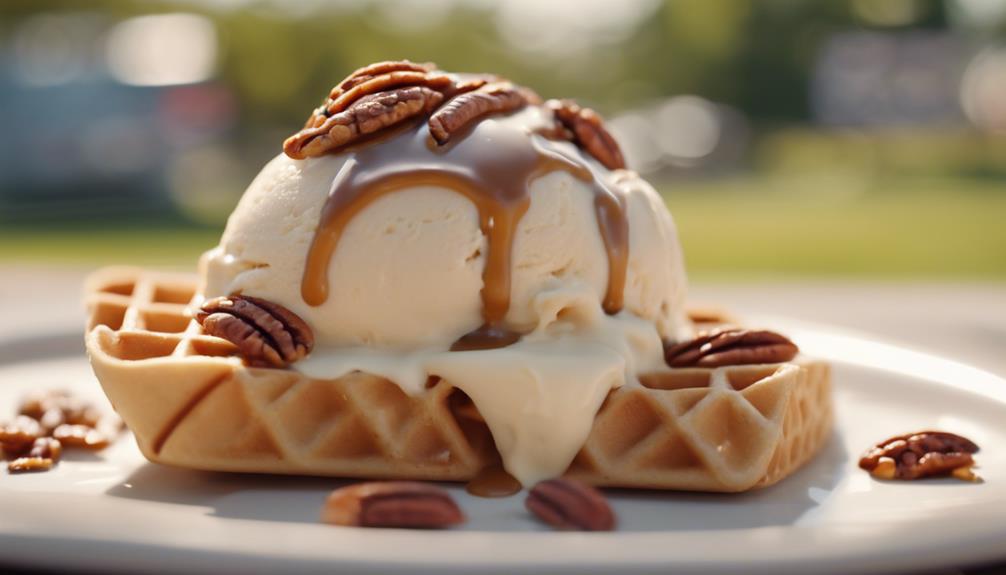
Savor a delicious summer treat with our Butter Pecan Ice Cream recipe. Mix butter, brown sugar, cream, and pecans for a creamy delight. Melt butter, cook pecans, whisk eggs, and blend for a rich flavor. Add pecans, cream, and vanilla, then freeze to perfection. Master this easy-to-follow recipe for a tasty dessert to beat the heat.
Key Takeaways
- Rich and creamy blend of butter, brown sugar, and heavy cream
- Toasted pecans for a nutty crunch and flavor
- Easy-to-follow steps for homemade ice cream perfection
- Customization options with variations like bourbon or chocolate
- Perfect summer treat with a decadent, refreshing taste
Recipe Ingredients for Butter Pecan Ice Cream
To create a delectable batch of butter pecan ice cream, gather the essential ingredients listed in the recipe.
You'll need:
- Butter
- Brown sugar
- Heavy cream
- Pecans
These ingredients combine to bring out the rich and nutty flavors of this classic dessert.
The brown sugar adds a caramel-like sweetness, while the heavy cream contributes to a creamy texture that's essential for a decadent treat.
Pecans, when toasted in butter, provide a delightful crunch and enhance the overall flavor profile of the ice cream.
Cooking Instructions for Homemade Ice Cream
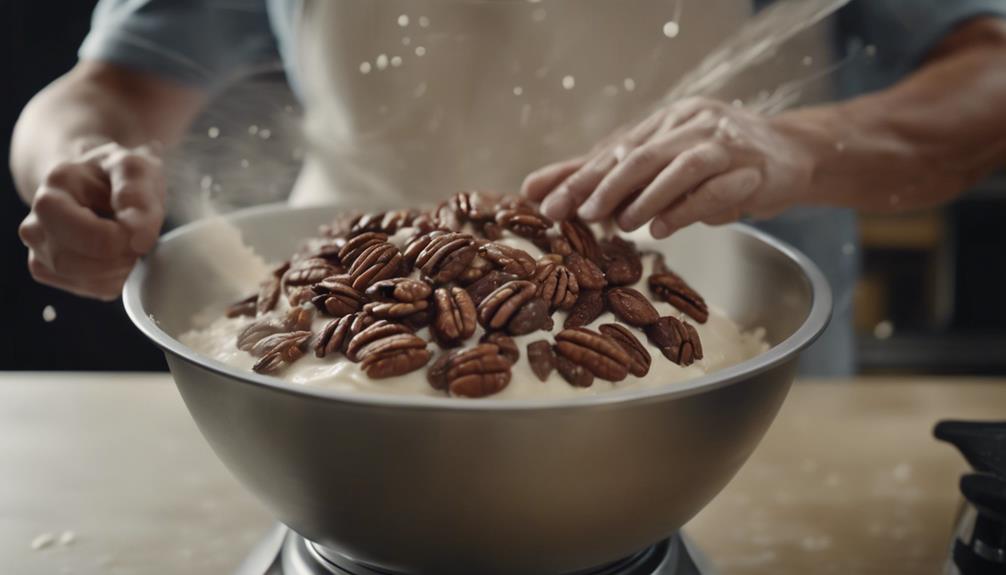
Start by melting butter in a skillet to infuse the pecans with a rich, nutty flavor for your homemade butter pecan ice cream.
Here's a quick guide to help you make this creamy delight:
- Melt butter and cook pecans for flavor.
- Whisk eggs and combine with half-and-half and brown sugar for a creamy base.
- Cook until thickened, then mix with eggs in a bowl.
- Add cream, pecans, and vanilla extract.
- Freeze the mixture in an ice cream maker.
Following these steps will guarantee your homemade butter pecan ice cream turns out rich and delicious.
Remember to carefully adhere to the manufacturer's instructions for your ice cream maker to achieve the perfect consistency.
Enjoy the process of creating this delightful treat that will surely be a hit during the summer months.
Ice Cream Preparation Steps

Mix half and half with brown sugar over medium heat in a large bowl to prepare the ice cream base.
Next, whisk beaten eggs and temper them with the warm milk mixture to create a smooth custard.
Once done, thicken the mixture on low heat, then cool it over an ice bath to achieve ideal texture.
After that, stir in heavy cream, vanilla extract, maple extract, and a pinch of salt for rich flavor.
Remember to refrigerate the mixture for 1 1/2 – 2 hours before churning it into creamy butter pecan ice cream.
This process ensures that the flavors meld together beautifully and the ice cream attains the perfect consistency for scooping and savoring.
Nutritional Information and Tips
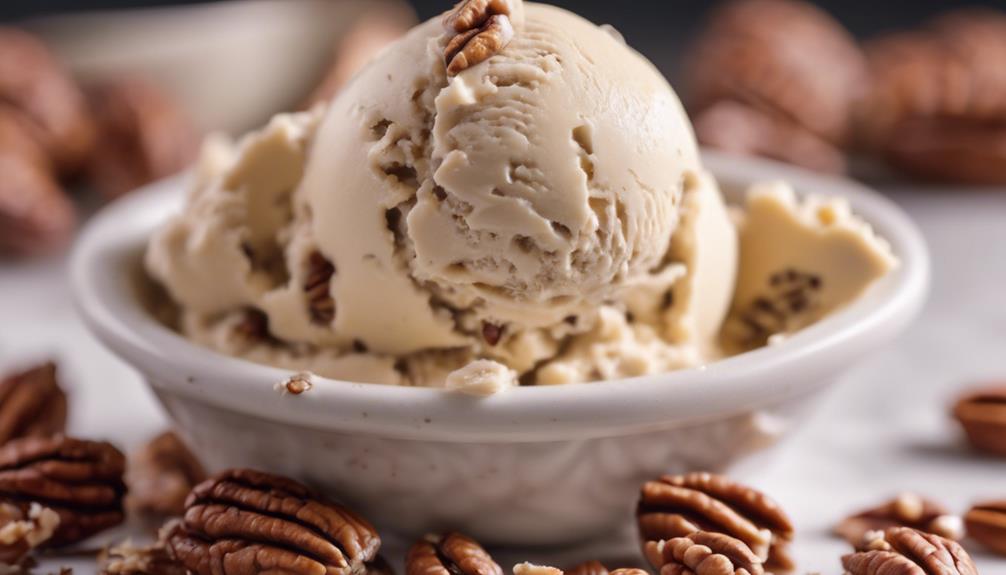
Considering the rich and creamy nature of homemade butter pecan ice cream, it's important to be mindful of its nutritional content and serving size. When indulging in this delectable dessert, remember these essential tips:
- Portion Control: Enjoy in moderation to savor the flavors without overindulging.
- Brown Sugar Sweetness: Opt for a moderate amount of brown sugar to balance sweetness without overwhelming the palate.
- Room Temperature Ingredients: Confirm ingredients like butter and heavy cream are at room temperature for a smoother texture.
- Nutritional Awareness: Be mindful that homemade butter pecan ice cream can vary in nutritional content, so adjust ingredients accordingly.
- Consultation: Seek advice from a nutritionist or healthcare provider for personalized guidance on incorporating this treat into a balanced diet.
Homemade Butter Pecan Ice Cream Variations

Explore creative twists on traditional butter pecan ice cream by incorporating different nuts, spirits, sauces, chocolates, and dairy-free alternatives.
For a unique flavor, try substituting pecans with walnuts or almonds in the full recipe. Toast the nuts in a separate bowl until browned and fragrant, then chop them finely enough to coat in the ice cream mixture.
To add a boozy kick, mix in a splash of bourbon or rum to the base as you churn the ice cream. For an extra indulgent touch, swirl in caramel sauce or fudge ripple throughout the mixture.
Incorporate chunks of chocolate or chocolate-covered nuts for a delightful contrast in texture, giving each bite a sweet surprise.
If you prefer a lighter, dairy-free option, consider using coconut milk or almond milk as a substitute for traditional dairy products. These alternatives provide a creamy base while catering to plant-based diets.
Experiment with these variations to create a personalized butter pecan ice cream that suits your taste preferences.
Frequently Asked Questions
What Is the Secret to Making Ice Cream Very Creamy?
To make ice cream very creamy, you use a rich base of ingredients like heavy cream, eggs, and sugar. Chilling the base before churning is crucial for a smoother texture. Adding vanilla extract enhances creaminess, and slow churning prevents a dense outcome.
What Flavor Is the Ice Cream in Butter Pecan?
The ice cream in butter pecan is a delightful blend of buttery richness, vanilla sweetness, and maple undertones, perfectly paired with toasted pecans for a nutty crunch. This flavor combination creates a harmonious and indulgent treat.
What's the Difference Between Butter Pecan Ice Cream and Praline Pecan Ice Cream?
In butter pecan ice cream, you'll savor the buttery richness of pecans blended with a creamy base. On the other hand, praline pecan ice cream highlights caramelized sweetness with a swirl of praline sauce for a delightful flavor contrast.
What Age Group Eats Butter Pecan Ice Cream?
You'll find that adults and older individuals, typically in the 30-60 age group, enjoy butter pecan ice cream. It's a favorite among those with a more refined palate, drawn to its rich and nutty flavor.
Conclusion
So there you have it, folks! Whip up this buttery, nutty delight for a taste of summer in every scoop.
Don't cry over spilled milk – grab a cone and enjoy this creamy treat that's sure to satisfy your sweet tooth.
Get churning and indulge in the best butter pecan ice cream you've ever tasted!
Sunny’s articles radiate enthusiasm, much like her sunny disposition. As our resident “Butter Geek”, she delves deep into the latest butter trends, ensuring our readers are always in the know. Beyond her writing, Sunny’s passion lies in exploring vegan butter alternatives and hosting butter-tasting soirées.
Recipes & Culinary Uses
Festive Favorites: Best Peanut Butter Blossoms Recipe for Holidays!
Unleash the ultimate holiday baking magic with the best Peanut Butter Blossoms recipe – an irresistible treat that will elevate your festive celebrations!

Elevate your holiday baking with the ultimate Peanut Butter Blossoms recipe. Cream together peanut butter, butter, sugars, and salt, then add egg and vanilla. Roll dough into balls, coat in brown sugar, bake until golden, then press a Hershey's kiss on top. Adjust baking time as needed. Explore ingredient swaps for a personalized touch. Enjoy with hot cocoa or pair with savory dishes. For more tips, ideas, and customization options, the recipe holds more festive surprises.
Key Takeaways
- Cream together peanut butter, butter, sugars for rich flavor.
- Bake at 375°F for 8-10 minutes for soft, chewy cookies.
- Customize with ingredient swaps like almond butter or maple syrup.
- Pair with savory dishes or hot cocoa for holiday enjoyment.
- Press Hershey kisses onto warm cookies for a classic finish.
Ingredients for Peanut Butter Blossoms
For the classic Peanut Butter Blossoms recipe, gather peanut butter, butter, sugar, an egg, and Hershey's kisses as your essential ingredients.
Peanut butter is the star, offering a rich flavor that blends perfectly with the sweetness of the cookies.
Butter plays a pivotal role by adding moisture and richness to the dough, ensuring a soft and chewy texture.
The sugar not only sweetens the cookies but also contributes to their festive appeal, making them a perfect treat for any occasion.
Finally, the Hershey's kisses on top provide a delightful chocolatey finish that elevates these cookies to a whole new level of deliciousness.
Together, these ingredients create a harmonious blend of flavors and textures that make Peanut Butter Blossoms a beloved classic for holiday baking or any time you crave a sweet and satisfying treat.
Recipe Steps for Peanut Butter Blossoms
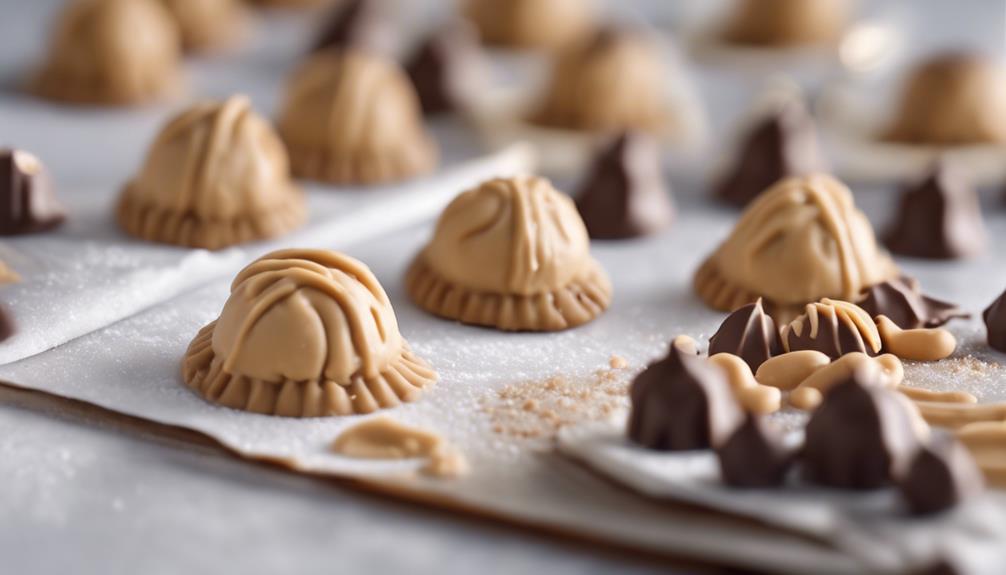
To make Peanut Butter Blossoms, start by creaming together peanut butter, butter, sugars, and salt until light and fluffy.
Next, add in the egg and vanilla extract, making sure to mix well to combine all the ingredients thoroughly.
Then, gradually incorporate the dry ingredients into the wet mixture until a smooth dough forms.
Once the dough is ready, roll it into balls and coat each ball generously in brown sugar.
Place the sugar-coated dough balls on a baking sheet, making sure to leave enough space between them for spreading during baking.
Bake the cookies in a preheated oven until they turn a beautiful golden brown.
As soon as the cookies are out of the oven, press a Hershey's kiss into the center of each cookie gently.
The heat from the freshly baked cookies will melt the chocolate just enough to adhere it to the cookie.
These Peanut Butter Blossoms are a delightful treat perfect for Christmas celebrations!
Pro Tips for Making Peanut Butter Blossoms
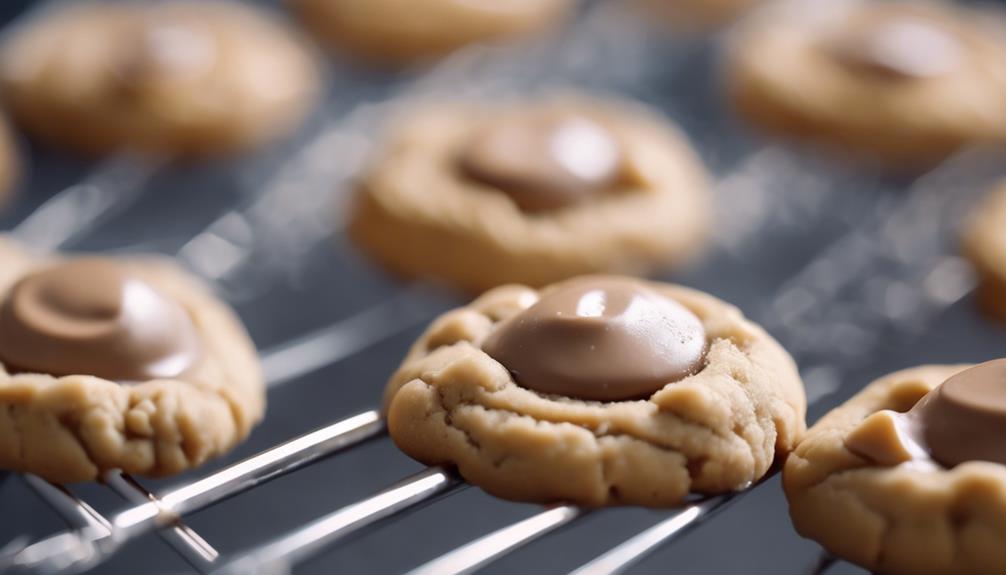
To enhance your peanut butter blossom baking experience, consider adjusting the baking time based on your oven's performance for best results.
Additionally, explore ingredient substitutions to cater to dietary preferences or allergies without compromising the flavor or texture of the cookies.
These pro tips can help you customize your peanut butter blossoms while ensuring delicious outcomes.
Baking Time Recommendations
Achieving the ideal texture for your peanut butter blossoms involves baking them at 375°F for 8-10 minutes. This baking duration guarantees that the cookies have a soft and chewy consistency while allowing the Hershey kisses on top to be softened but not completely melted.
Once out of the oven, remember to press the Hershey kisses onto the cookies immediately to secure them in place for that classic appearance.
For the best outcomes, chill the cookie dough for about 30 minutes before baking. This step helps the cookies maintain their shape and prevents excessive spreading during baking, ensuring your peanut butter blossom cookies are perfectly formed and ready to impress during your holiday baking.
Shortening or extending the baking time can alter the texture of the cookies. A quick bake of 6-8 minutes produces softer and chewier cookies, while longer baking times yield a slightly crispier consistency. Stick to the recommended 8-10 minutes for the best soft and chewy peanut butter blossoms.
Ingredient Substitutions
Consider incorporating different ingredients to elevate the flavor and nutritional profile of your peanut butter blossoms. For a healthier option, swap out shortening with unsalted butter to achieve a unique texture and taste in your cookies.
Try using natural peanut butter instead of creamy to add a wholesome twist to the classic recipe. If you're looking to reduce the glycemic impact, substitute brown sugar with coconut sugar in your baking. For a natural sweetener alternative, replace regular granulated sugar with maple syrup in the cookie dough mixture.
Additionally, for a distinct flavor experience, experiment with almond butter as a substitute for peanut butter in your blossoms. These ingredient substitutions can bring a new dimension to your peanut butter blossoms, making them not only delicious but also tailored to your dietary preferences.
Upgrade your baking game this holiday season with these creative twists on a beloved recipe!
Serving Suggestions for Peanut Butter Blossoms

Enhance the enjoyment of your peanut butter blossoms by pairing them with savory dishes like lasagna tortellini soup for a satisfying meal. These classic cookies also complement family-friendly dinners such as easy ground beef shepherd's pie and creamy broccoli cheddar soup, making for a delightful combination. The holiday season calls for cozy treats, and the sweet nuttiness of peanut butter blossoms pairs perfectly with a warm cup of hot cocoa. Whether you're participating in a cookie exchange or looking for a festive touch to your holiday dessert spread, consider rolling the cookies in red, green, and white sugar sprinkles to add a pop of color and fun.
| Serving Suggestions | Pairing Ideas |
|---|---|
| Lasagna Tortellini Soup | Comforting and hearty meal alongside the cookies |
| Easy Ground Beef Shepherd's Pie | Delicious combination for a family dinner |
| Creamy Broccoli Cheddar Soup | Perfect accompaniment to the nutty cookie flavors |
12 Days of Christmas Cookies Recipes

Indulge in a variety of delightful Christmas cookie recipes each day during the holiday season. One standout choice is the classic Peanut Butter Blossoms. These holiday cookies feature a peanut butter base topped with a Hershey's kiss, making them a beloved treat for cookie exchanges and festive gatherings.
The process of making these cookies is simple yet rewarding. Start by rolling the dough balls in sugar before baking to add a sweet crunch to each bite. The combination of rich peanut butter flavor and the chocolatey goodness of the Hershey's kiss creates a perfect balance of sweetness.
When enjoying these Christmas cookies, consider pairing them with a glass of milk for a classic and satisfying treat.
Whether you're baking them for your family, a cookie exchange, or a holiday party, Peanut Butter Blossoms are sure to be a hit. Make each day of the holiday season a little sweeter with these delicious cookies.
User Engagement Features
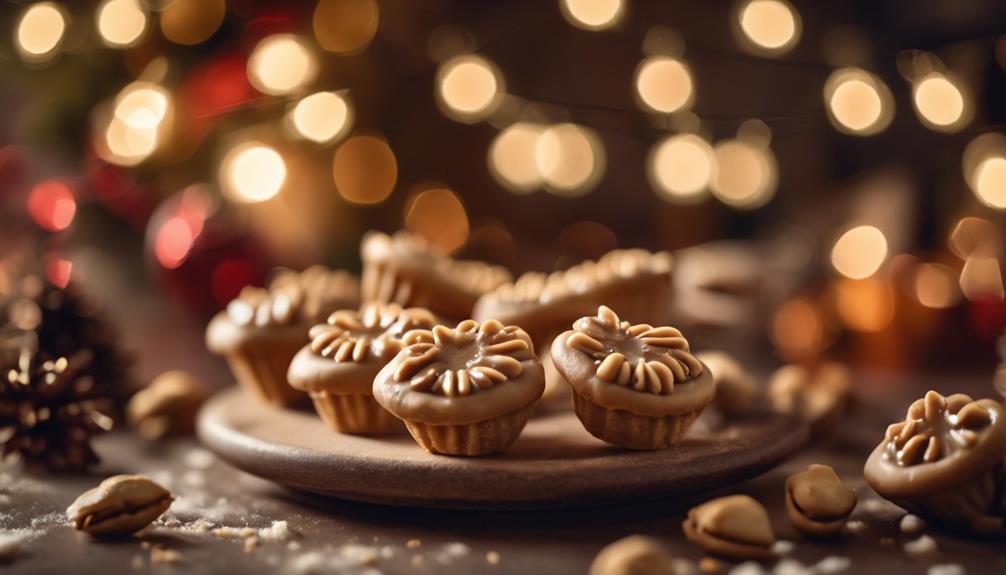
Let's talk about how user interaction features and personalization options enhance your experience with the Peanut Butter Blossoms recipe.
You can engage with others by leaving comments and sharing your results, creating a sense of community around this holiday treat.
Personalization options like name and email entry fields help tailor the experience to your preferences, making it more engaging and enjoyable.
User Interaction Features
Utilizing user engagement features on the website allows for increased participation and feedback from visitors. The comment section enables users to interact with each other and provide valuable feedback on the Peanut Butter Blossoms recipe or share their experiences with Hershey's kisses. By incorporating a reply option, users can engage in conversations, fostering a sense of community around baking these delightful peanut butter cookies.
Moreover, the inclusion of name and email fields not only allows for personalization but also facilitates communication between the website and its visitors. This data storage feature guarantees that users can conveniently access their information for future visits, enhancing their overall user experience.
These user engagement features play an essential role in creating an interactive platform where users can engage, provide feedback, and communicate effectively. Such interaction not only enriches the user experience but also encourages visitors to actively participate in the community surrounding the Peanut Butter Blossoms recipe.
Personalization Options
Enhance your website's user engagement by incorporating personalized options such as commenting, replying, and sharing feedback on the Peanut Butter Blossoms recipe. This level of user interaction not only fosters a sense of community building but also encourages customization and feedback. By allowing users to share their thoughts, results, and experiences with the festive favorites, you create a more engaging and interactive user experience. Additionally, providing users with the option to save their data for future visits and encouraging them to tag @preppykitchen and use #preppykitchen when trying the recipe further enhances their engagement.
| Personalization Options | Description | Benefits |
|---|---|---|
| Commenting | Users can leave comments on the Peanut Butter Blossoms recipe, sharing their thoughts and experiences. | Fosters community building and user engagement. |
| Replying | Users can reply to comments and engage in discussions with other users about the recipe. | Encourages active participation and interaction. |
| Feedback Sharing | Users can share feedback on the recipe, providing valuable insights for improvement. | Enhances user experience and customization. |
Additional Information

You may find it interesting to know more about the history of the Peanut Butter Blossoms recipe and its cultural significance during the holidays.
- The Peanut Butter Blossoms recipe's popularity is backed by IRI MULO data, making it a sought-after choice for holiday baking.
- Copyright for this beloved recipe belongs to The J.M. Smucker Company, a reputable name in the food industry known for quality products.
- These delightful cookies aren't only perfect for serving at holiday parties but also make excellent gifts due to their festive appeal.
Frequently Asked Questions
Why Are My Peanut Butter Blossoms Dry?
If your peanut butter blossoms are dry, it could be due to using too much flour, overbaking, using natural peanut butter that requires stirring, or not enough butter/shortening. Guarantee precise measurements and follow the recipe closely to maintain moisture.
Why Did My Peanut Butter Blossoms Go Flat?
When making peanut butter blossoms, going flat happens due to overmixing, too much flour, insufficient chilling, or low oven temperature. Remember to avoid these pitfalls. Preheat the oven properly and follow the recipe for perfect blossoms!
What Is America's Favorite Christmas Cookie?
America's favorite Christmas cookie is Peanut Butter Blossoms. Loved for their peanut butter-chocolate combo and nostalgic Hershey's Kiss center, these easy-to-make treats are a holiday staple at parties and gatherings. They're a must-have during the festive season.
What Is Baskin Robbins Peanut Butter Blossom?
You asked about Baskin Robbins Peanut Butter Blossom. It's a delectable seasonal ice cream flavor featuring creamy peanut butter ice cream with a ribbon of more peanut butter and chocolate cookie pieces. Indulge in this festive treat!
Conclusion
Indulge in the warm, gooey goodness of these peanut butter blossoms this holiday season. With the perfect blend of creamy peanut butter and rich chocolate, these cookies are sure to bring joy to your festivities.
Picture yourself surrounded by loved ones, sharing laughter and memories as you enjoy these delicious treats. Let the aroma of freshly baked cookies fill your home and create a cozy, festive atmosphere.
Happy baking and happy holidays!
Sunny’s articles radiate enthusiasm, much like her sunny disposition. As our resident “Butter Geek”, she delves deep into the latest butter trends, ensuring our readers are always in the know. Beyond her writing, Sunny’s passion lies in exploring vegan butter alternatives and hosting butter-tasting soirées.
Recipes & Culinary Uses
Bite-Sized Treats: Best Peanut Butter Ball Recipe You'll Love!
Adore these heavenly peanut butter balls with a delectable mix of smooth peanut butter, powdered sugar, and vanilla—perfect for indulging in bite-sized bliss!
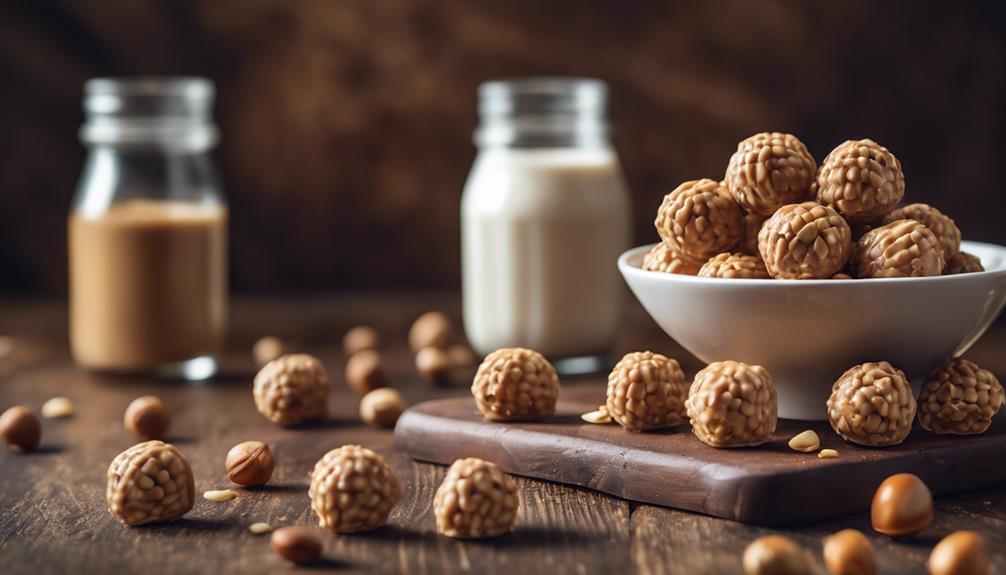
You'll adore these easy and heavenly peanut butter balls. Mix smooth peanut butter, powdered sugar, and vanilla extract for a delectable dough. Roll into small balls and chill. Dip in melted chocolate, then refrigerate to set. Enhance the flavor with rum extract, nuts, or crushed pretzels. Get creative with colorful sprinkles and different chocolate coatings. Use quality chocolate coating and adjust mix consistency. Store them in the fridge or freezer. Enjoy these mouthwatering treats alone or at gatherings. More tips and delightful variations await!
Key Takeaways
- Creamy peanut butter, powdered sugar, and vanilla create a smooth dough.
- Incorporate nuts, rum extract, or pretzels for flavor and texture variety.
- Use quality chocolate coating like candy melts for best results.
- Chill peanut butter balls before dipping for easier handling.
- Store in the fridge or freezer for convenient snacking and serving.
Ingredients and Preparation
To create irresistible peanut butter balls, gather creamy peanut butter, powdered sugar, and vanilla extract as your key ingredients.
Begin by mixing the peanut butter, butter, sugar, and vanilla until you have a smooth dough. Roll this mixture into small balls and chill them before dipping them in melted chocolate.
The type of chocolate you use, such as dark or milk chocolate, will enhance the flavor of your peanut butter balls. After dipping, make sure to refrigerate the balls until the chocolate sets for a perfect finish.
This process guarantees that each bite-sized treat isn't only visually appealing but also bursting with delicious peanut butter and chocolate flavors.
Variations and Enhancements

You can elevate the flavor of your peanut butter balls by incorporating unique ingredients like chopped nuts or rum extract.
Experiment with different chocolate coatings such as white almond bark or dark chocolate candy melts for a varied taste experience.
Get creative by adding finishing touches like colorful sprinkles to make your peanut butter balls visually appealing.
Flavorful Ingredient Additions
Enhance the flavor of your peanut butter balls by incorporating unique ingredient variations and enhancements. While the classic combination of peanut butter, powdered sugar, and butter creates a delicious dough for your treats, you can take it up a notch by adding flavorful ingredient additions.
Consider mixing in crushed pretzels for a salty crunch that complements the sweetness of the peanut butter. Chopped nuts like almonds or pecans can also add a delightful texture and nutty taste to your chocolate-covered peanut butter balls.
For a burst of fruity flavor, try incorporating dried cranberries or raisins into the dough. These additions not only provide a contrast in texture but also introduce a hint of sweetness that pairs well with the creamy peanut butter.
Another option is to include a sprinkle of cinnamon or a dash of vanilla extract to elevate the overall taste profile of your peanut butter balls. Experiment with these flavorful ingredient additions to create a unique and delectable twist on the classic treat.
Chocolate Coating Options
Experiment with different types of chocolate coatings – dark, white, or milk chocolate – to suit your preferences and elevate the flavor of your peanut butter balls.
When considering the chocolate coating for your crunchy peanut butter treats, here are some options to enhance your culinary creation:
- Choose Candy Melts or Almond Bark: Opt for candy melts or almond bark for a smooth and firm chocolate coating that sets well on your peanut butter balls.
- Avoid Chocolate Chips: Steer clear of using chocolate chips for coating, as they may contain stabilizers that hinder smooth melting, affecting the overall texture.
- Add Colored Sprinkles: For a festive touch, sprinkle colored sprinkles on top of the chocolate coating before it sets to add a pop of color and extra crunch to your peanut butter balls.
Experimenting with different chocolate coatings and techniques can take your peanut butter balls to the next level, ensuring a delightful and indulgent treat for any occasion.
Creative Finishing Touches
To elevate the flavor profile of your peanut butter balls, consider incorporating creative finishing touches through various enhancements and unique variations.
You can enhance the texture by adding chopped nuts or crispy rice cereal to the peanut butter mixture, providing a delightful crunch with every bite.
Experiment with different flavors by using almond extract or rum extract instead of vanilla for a twist on the traditional taste.
For a festive touch, roll the balls in crushed graham crackers, sprinkles, or a sprinkle of sea salt to add a pop of flavor.
Drizzle white chocolate over the dark, semi-sweet, or milk chocolate coating for a visually appealing contrast that will impress your guests.
If you enjoy a crunchy element, try coating the balls in crushed pretzels or toasted coconut before the chocolate sets.
These creative enhancements will take your peanut butter balls to the next level, making them a standout treat at any gathering.
Tools and Tips
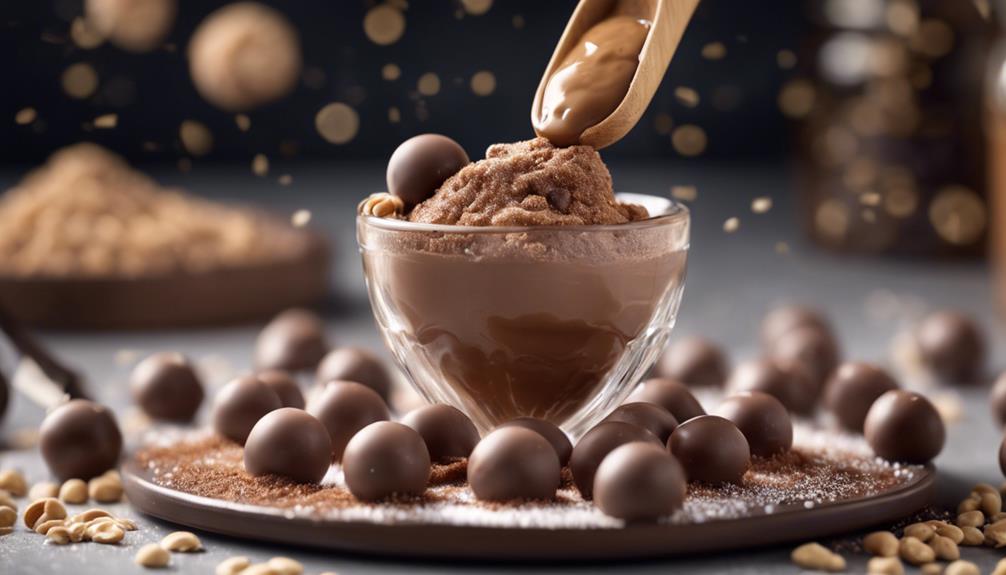
Consider using a 1 tablespoon cookie scoop for consistent sizing when preparing your peanut butter balls. This tool will help guarantee all your treats are uniform in size, making for a neat presentation and even cooking.
Here are some additional tools and tips to enhance your peanut butter ball-making experience:
- Invest in Quality Chocolate Coating: Opt for candy melts or almond bark for a smooth and firm chocolate coating on your peanut butter balls. These coatings melt easily and provide a professional finish to your treats.
- Adjust Peanut Butter Mixture Consistency: If your peanut butter mixture is too sticky or too dry, adjust the consistency by adding more peanut butter or powdered sugar. This will help you achieve the perfect texture for shaping your balls.
- Refrigerate Before Dipping: Prior to dipping your peanut butter balls in chocolate, chill them in the refrigerator. This step will make the balls firmer, making them easier to handle and coat without falling apart.
Storage and Serving Suggestions
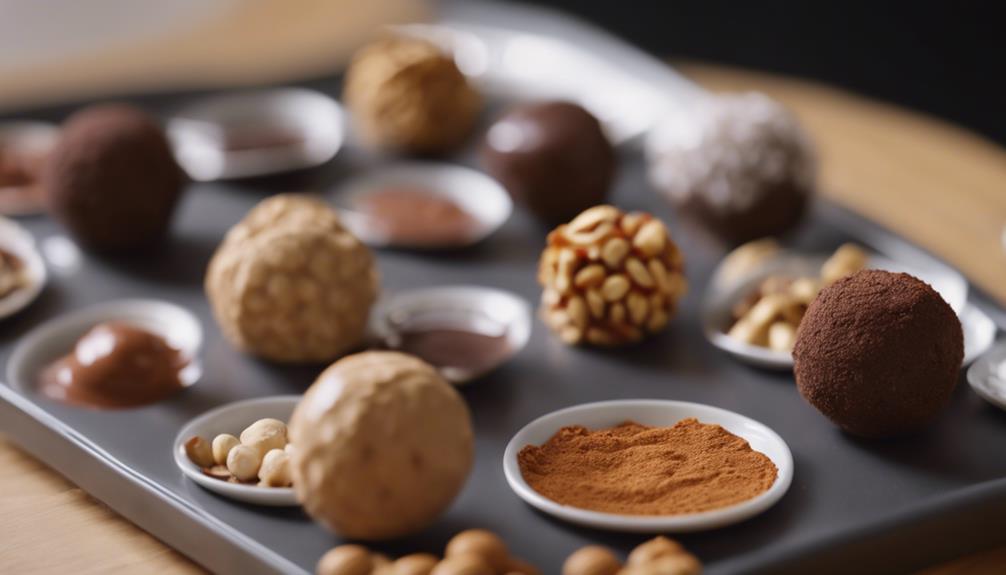
For best freshness and presentation of your peanut butter balls, follow these storage and serving suggestions.
To keep your peanut butter balls tasting delicious, store them properly. You can store them in an airtight container in the fridge for up to 1 week or in the freezer for up to 2 months. When freezing, remember to thaw the frozen peanut butter balls before serving by bringing them to room temperature. To prevent them from sticking together, separate the layers of peanut butter balls with wax paper.
Here is a helpful table summarizing the storage and serving suggestions:
| Storage | Serving | Frozen |
|---|---|---|
| Airtight container | Display on festive tray | Thaw before serving |
| Fridge – 1 week | Pair with hot cocoa | Bring to room temp |
| Freezer – 2 months | Enjoy at holiday gatherings | |
| Separate with wax paper |
Additional Peanut Butter Desserts
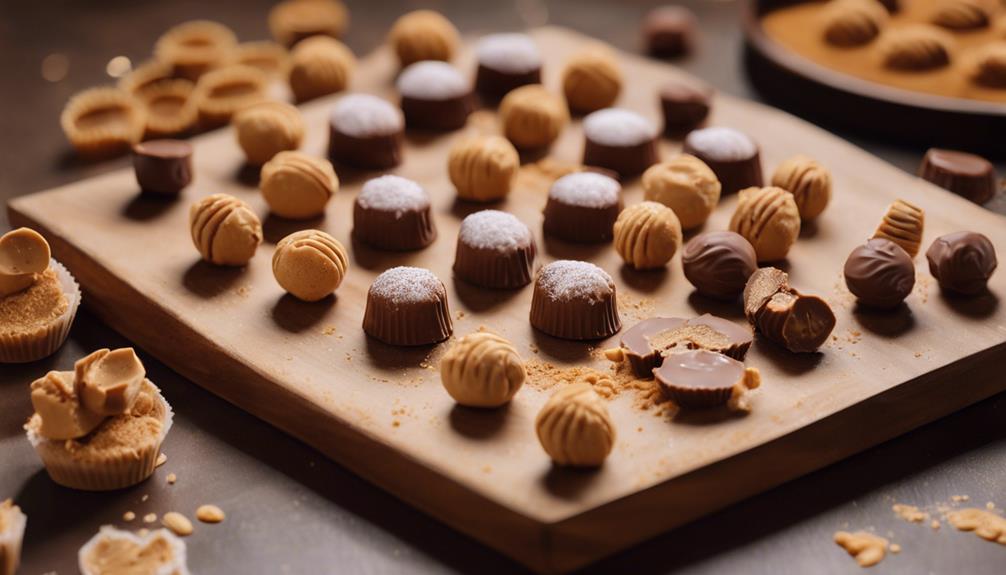
Explore a variety of delectable peanut butter desserts to satisfy your sweet cravings.
- Peanut Butter Blossom Cookies: Indulge in the classic combination of peanut butter cookies topped with a chocolate kiss for a delightful treat.
- Peanut Butter Chocolate Mug Cake: Whip up this easy-to-make single-serving dessert that combines the rich flavors of peanut butter and chocolate in a mug for a quick fix.
- Peanut Butter Overload Cookies: For those who can't get enough peanut butter, these cookies are loaded with peanut butter chips, chocolate chips, and chopped peanuts for an explosion of flavor in every bite.
These additional peanut butter desserts offer a diverse selection to cater to your cravings.
Whether you're in the mood for a classic treat like Peanut Butter Blossom Cookies, a quick fix with Peanut Butter Chocolate Mug Cake, or a flavor-packed experience with Peanut Butter Overload Cookies, there's something for every peanut butter lover.
Enjoy these easy-to-make delights whenever you need a sweet pick-me-up!
Recipe Instructions and Nutritional Information
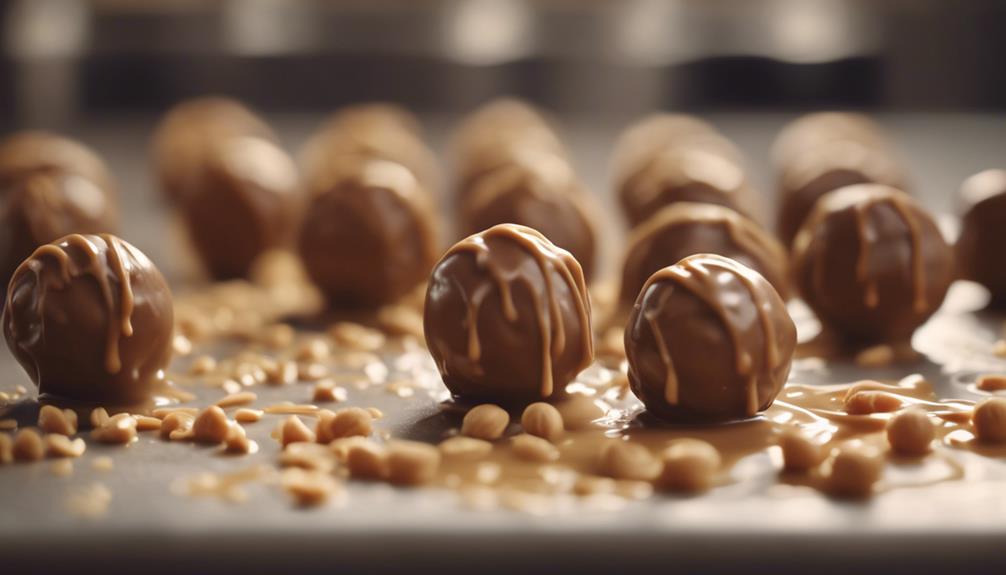
To create these delectable Peanut Butter Balls, start by blending peanut butter, butter, sugar, and vanilla to form a dough. Roll the mixture into small balls and place them on a baking sheet lined with parchment paper. Chill the peanut butter balls in the refrigerator for about 30 minutes until firm.
Once chilled, melt chocolate in a heatproof bowl over simmering water or in the microwave. Dip each chilled peanut butter ball into the melted chocolate, ensuring they're evenly coated. Place the coated balls back on the parchment paper and let the chocolate set.
Each serving of these delightful treats contains approximately 114 calories.
Store the finished peanut butter balls in the fridge for up to 2 weeks or freeze them for up to 3 months.
Enjoy these decadent bite-sized snacks whenever you crave a sweet and nutty indulgence.
Frequently Asked Questions
Can I Use Chunky Peanut Butter Instead of Creamy for This Recipe?
Yes, you can use chunky peanut butter instead of creamy for this recipe. It will add a delightful texture and extra crunch to your peanut butter balls. Enjoy experimenting with different variations!
How Long Do Chocolate Covered Peanut Butter Balls Stay Fresh?
Like a sweet memory, chocolate-covered peanut butter balls stay fresh for up to two weeks when stored in an airtight container in the fridge. Indulge in these delectable treats within that time frame for best taste.
Can I Freeze the Peanut Butter Balls for Later Enjoyment?
Yes, you can freeze the peanut butter balls for later enjoyment. Simply place them in an airtight container or freezer bag. When ready to indulge, let them thaw in the fridge for a few hours.
What Type of Chocolate Is Best for Coating the Peanut Butter Balls?
For coating the peanut butter balls, semi-sweet or milk chocolate works best. They provide a delicious contrast to the creamy peanut butter filling. Simply melt the chocolate, dip the balls, and enjoy the sweet treat!
Can I Add Chopped Nuts or Sprinkles to the Peanut Butter Balls for Extra Flavor?
You can definitely add chopped nuts or sprinkles to the peanut butter balls for extra flavor. It's a great way to customize your treats and add a delightful crunch or colorful touch to each bite.
Conclusion
Indulge in these irresistible peanut butter balls that are sure to satisfy your sweet tooth cravings.
With just a few simple ingredients and easy-to-follow instructions, you can enjoy these bite-sized treats in no time.
So go ahead, treat yourself to a little taste of heaven and experience the perfect combination of creamy peanut butter and rich chocolate.
You won't be able to resist coming back for more!
Sunny’s articles radiate enthusiasm, much like her sunny disposition. As our resident “Butter Geek”, she delves deep into the latest butter trends, ensuring our readers are always in the know. Beyond her writing, Sunny’s passion lies in exploring vegan butter alternatives and hosting butter-tasting soirées.
-

 Recipes & Culinary Uses2 months ago
Recipes & Culinary Uses2 months agoHow Many Sticks of Butter Equals a Pound: A Handy Guide
-

 Shopping Guides1 month ago
Shopping Guides1 month agoWhere to Buy Raw Butter
-

 Recipes & Culinary Uses4 weeks ago
Recipes & Culinary Uses4 weeks agoMake Homemade Butter from Milk at Home
-

 Recipes & Culinary Uses4 weeks ago
Recipes & Culinary Uses4 weeks agoMake Creamy Butter From Buttermilk
-

 Butter Tips and Tricks3 months ago
Butter Tips and Tricks3 months agoHow Long Can You Use Butter After the Expiration Date?
-

 Recipes & Culinary Uses2 months ago
Recipes & Culinary Uses2 months agoMake Your Own Homemade Spray Butter
-

 Butter Tips and Tricks3 months ago
Butter Tips and Tricks3 months agoHow Much Butter to Use Instead of 1/3 Cup Oil
-

 Butter Tips and Tricks3 months ago
Butter Tips and Tricks3 months agoHow Many Calories Are in a Stick of Butter: A Comprehensive Guide








